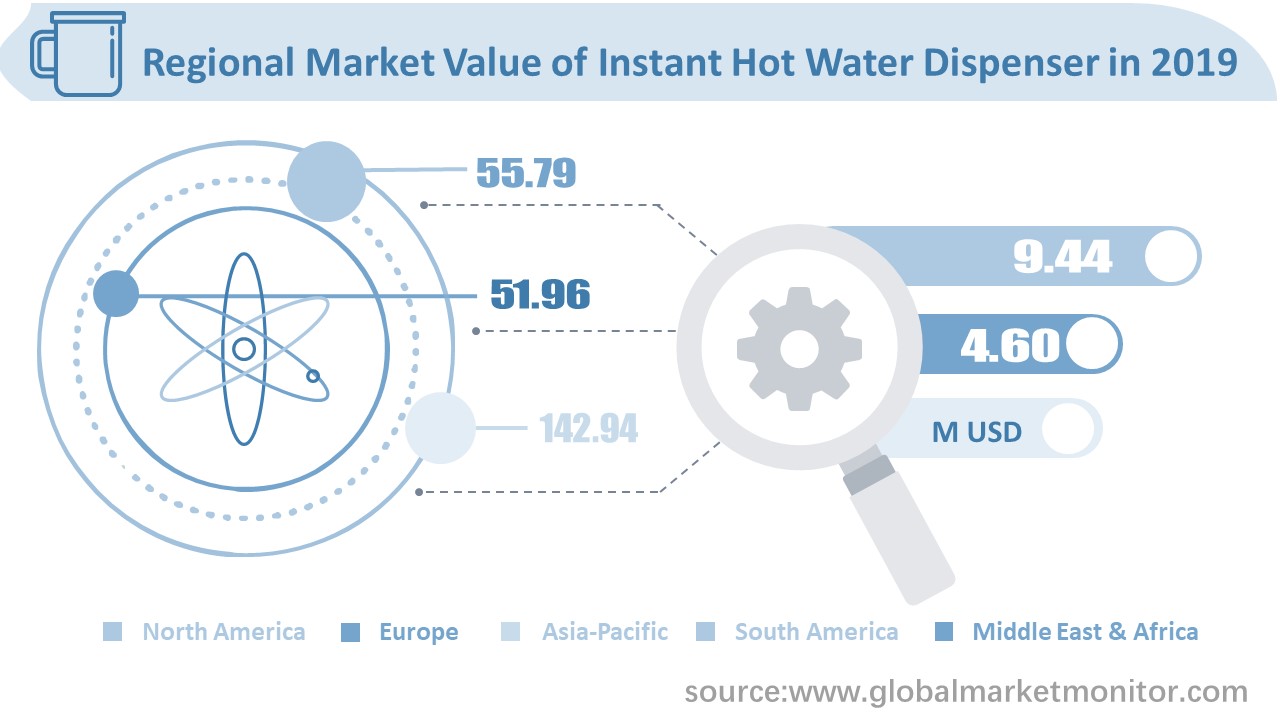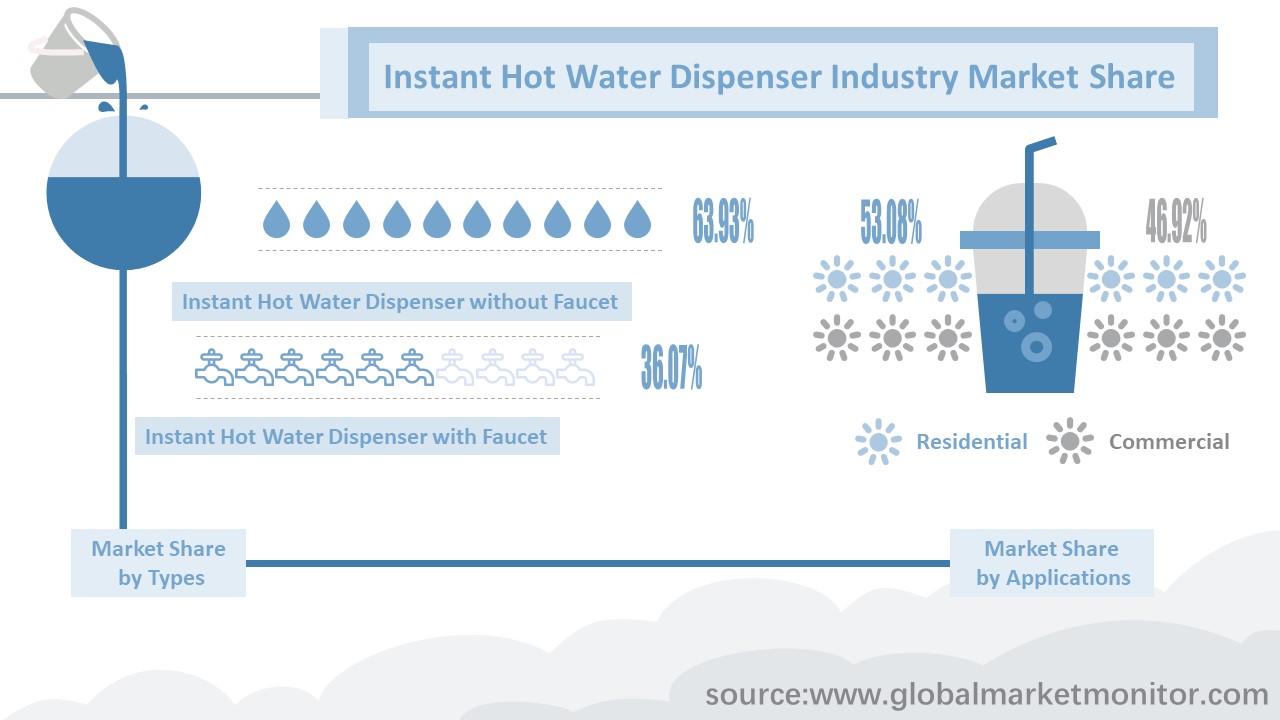COVID-19 Outbreak-Global Instant Hot Water Dispenser Industry Market Report-Development Trends, Threats, Opportunities and Competitive Landscape in 2020
The instant water dispenser is a kind of high-tech intelligent and innovative water dispenser that does not need to wait for hot water, press and release, and does not need to be heated repeatedly, which is different from traditional water dispensers and the water is at about 94 °C (near boiling). There are hot-only and hot and cool water models, and the water may be filtered as well as heated. Instant hot water dispensers are very similar to portable shower devices; the latter is fitted with a heating element and quickly heats up the water, once a switch has been activated. Instant water drinking machine can use a kind of heating body with strong thermal conductivity under high power state to convert electric energy into heat energy, and then the heat energy transfers the heat to the water, and the powerful heat can quickly heat the water.
Instant hot water dispenser can be divided into that with faucet and that without faucet. Instant hot water dispenser with faucet is connected to the building's water supply for a continuous supply of water and electricity to run a heating unit to heat the incoming water. Generally speaking, Instant hot water dispenser with faucet's high-arch spout design provides maximum room under the faucet. And it completes with a coordinating water tank. Instant hot water dispenser without faucet refers to table top water dispensers, which can be placed on top of the table or counter space and connect it to the water line or use a Water tank. It's suitable for a small space; point of use water dispensers that are connected to a water supply and can have advanced filtration and sanitization technologies that remove sediment, reduce chemical contaminants, and get rid of off-tastes and odors as well as keep the outside (user interface) of the machine free of germs. In 2019, these two types of instant hot water dispenser respectively covered a market share of 36.07% and 63.93%.
Residential instant hot water dispensers are the dispensers people used at home. It’s private and convenient. Commercial instant hot water dispensers are relative to residential water dispensers. They are mainly installed and applied in various public commercial occasions, such as companies, schools, hospitals, restaurants, hotels, etc. In 2019, these two application fields respectively covered a market share of 53.08% and 46.92%.
Influence of COVID-19 Outbreak on Instant Hot Water Dispenser Industry Development
The Asia-Pacific region is the largest instant water dispenser revenue market, with a market share of 54.21% in 2019, followed by North America, with a market share of 21.16% in 2019. The instant hot water dispenser industry is highly concentrated. The top three companies in the industry are InSinkErator, Midea and Haier Brothers. In 2019, the market shares of the top three companies were 24.21%, 18.89% and 12.34%, respectively.
Different
industries are affected differently by the epidemic situation. The impact on instant
hot water dispenser is mainly reflected in the supply of material and operation
of the market. Affected by the COVID-19 epidemic, logistics will be suspended
and the supply of Instant Hot Water Dispenser will be tight. Due to the global
threat of COVID-19, the resumption of work in the factory will directly affect
the customer's production plan for goods and shipments. The continuous outbreak
of the international epidemic situation, if the personnel control of each
country is extended, it will affect the smooth supply of equipment and materials.
In addition to the impact on the upstream and downstream of the industry, the
sudden outbreak this year has awakened consumers' health awareness and raised
people's expectations and pursuit of a healthy life. Water
is the basic element of human survival. The health of water quality has been
paid more and more attention by people under the circumstance of
industrialization, modernization and increasingly serious environmental
pollution. More and more people begin to pay close attention
to the daily drinking water health, also to the requirement of water dispenser,
including: in addition to being able to filter the harmful material such as chemicals,
heavy metals in the water, water dispenser filter belt in bacteria and viruses
can also intercept filter the water, can also have the effect of antibacterial,
sterilization, further to ensure the safety of water quality. Therefore, in the
future, enterprises should also make corresponding adjustments in product
design and development strategy.
The Development of Intelligence Will Drive the Growth of Instant Hot Water Dispenser Market and Companies Must Build their own Brand
With the development and popularization of Internet and electronic products, intelligentization has come into people's life. The future trend of the public drinking water equipment industry is also bound to advance towards the direction of intelligence. First of all, in terms of energy-saving, traditional water dispensers boil water repeatedly until it is cooled after boiling, so that repeated use will consume a lot of power. The instant hot water dispenser has the function of heat preservation, heating and drinking at any time, which can save a lot of power. This water heater is equipped with a child lock, which can effectively avoid the risk of scalding due to improper operation. Currently, the two most common filtration methods on the market are ultrafiltration and RO reverse osmosis. In the performance of the harm, both kinds of filtration can filter the harmful substances in the water. But in terms of benefits, RO reverse osmosis filters out pure water, which filters out minerals that are beneficial to the human body. The ultrafiltration water is mineral water and can retain the mineral elements in the water. It is essential for the human body to retain mineral elements in drinking water. Proper filtration can remove harmful substances while retaining beneficial elements. Therefore, companies must step up their technological development and product innovation, considering customers’ pursuit of heath and requirement to create more cost-effective products to hold buyers and gain lager market share.
In the development process of the water dispenser industry, technical shortcomings have not yet been overcome. Besides, low consumer trust, and inadequate after-sales issues have become the ceiling that hinders the development of the industry. At present, it seems that the industry's mainstream ultrafiltration membrane filtration and reverse osmosis membrane filtration both have shortcomings and cannot fully meet consumer demand; insufficient technological innovation leads to product differentiation in terms of appearance and capacity, which has caused industry Qualitative competition; merchants exaggerate their promotional products so that the psychological gap between consumers is large, and the trust in the industry is reduced; regular replacement of filter cartridges for water purifiers is not necessary, and the merchant's after-sales system is not yet perfect, affecting consumers' after-sales experience, all these factors will hinder the whole industry’s development.
A
brand is an identification mark that carries a unique corporate culture and
unreproducible product attributes. It is an important manifestation of the
company's core competitiveness, and are important references for users to make
purchase decisions. In order to avoid homogeneous competition in the market,
manufacturers should actively innovate, produce high- quality products to
improve market competitiveness, and form their own brands to realize additional
value and enhance demand. While building the brand, it is necessary to
accelerate the technological innovation of the product, so as to emerge out of
the fierce market competition, which is also one of the future development trends.



